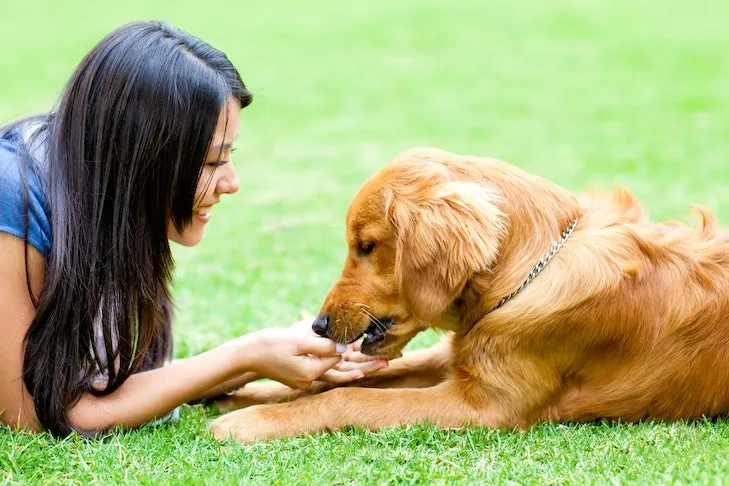Teaching your puppy to lie down is a fundamental and highly beneficial behavior. It serves as an excellent way to keep your puppy out of mischief and encourages a calm demeanor. However, many puppies initially resist getting into a down position or struggle to maintain it for more than a fleeting moment. This guide will walk you through three effective techniques for training the “down” command, along with valuable troubleshooting tips to make the process smoother for both you and your furry friend. A well-behaved puppy who can settle on command is often easier to manage in various situations, whether at home or out in public, helping them grow into a calm and happy companion. This foundational skill also complements other obedience training, such as learning how to train your dog not pull on its leash during walks.
Luring a Down Position
Luring is often the simplest method for introducing new behaviors. It involves using a treat or a favorite toy to physically guide your puppy into the desired position. For instance, if you hold a treat to your dog’s nose and move it in a circular motion, your puppy will naturally follow, performing a spin. The key to successful luring is to fade the lure as quickly as possible, ensuring your puppy responds to a hand signal or verbal cue rather than relying on the visual presence of the treat.
To maximize effectiveness, use a high-value lure that genuinely excites your puppy. Incorporating a clicker can also enhance communication by precisely marking the exact moment your dog performs the correct action. Here’s a step-by-step approach to teaching the “down” with a lure:
- Starting Position: With your puppy already in a sitting position, hold a tempting treat directly to their nose.
- Lowering the Head: Slowly move the treat downwards, between your puppy’s front paws. Your puppy should naturally lower their head to follow the treat.
- Guiding to Down: Continue moving the treat outwards along the ground, away from your puppy, essentially forming an “L” shape with your hand. As your puppy follows the treat, they should naturally lie down.
- Mark and Reward: The instant your puppy settles into the down position, click (if using a clicker) and offer enthusiastic verbal praise, then immediately give them the lured treat as a reward.
- Fading the Lure (Phase 1): After several successful repetitions, begin to use a treat from your other hand as the reward, so the lure itself is no longer consumed. This helps your puppy understand the treat is separate from the lure.
- Fading the Lure (Phase 2): Next, lure your puppy with an empty hand, rewarding them with a treat from your opposite hand. You’ve now established a hand signal – the motion of lowering your hand towards the ground.
- Adding a Verbal Cue: Once your puppy consistently responds to the hand signal, introduce the verbal cue by saying “Down” a second before you give the hand signal. With consistent practice, your puppy will eventually respond to the verbal cue alone.
If your puppy hasn’t yet mastered the “sit” command, you can still lure the “down” from a standing position. Simply guide the treat straight down to the ground between their front paws while they are standing. However, because the puppy has a greater distance to travel into the down position, you might find the “shaping” technique more effective in this scenario.
 Golden Retriever receiving a treat from a woman while calmly lying in the grass
Golden Retriever receiving a treat from a woman while calmly lying in the grass
Shaping a Down Position
Shaping is a gradual training method that breaks down a complex behavior into a series of smaller, manageable steps. For the “down” command, this could involve rewarding your puppy for simply looking at the ground, then for lowering their elbows, and finally for lying all the way down. The core principle of shaping is to set your puppy up for success by choosing an initial step that is easily achievable, then progressively increasing the difficulty without making jumps that are too large. It’s always better to make it too easy than to frustrate both you and your puppy by asking for too much too soon.
Begin by using a lure to encourage your puppy to glance at the ground. Click and praise, then reward this initial action. Once your puppy consistently masters this, proceed to lure their head further down towards the ground before clicking and rewarding. Subsequently, you might ask for bent elbows, and so forth. Focus on establishing the complete behavior through shaping before you worry about fading the lure or introducing a verbal cue. This method encourages your puppy to actively participate in the learning process and build confidence with each successful small step, contributing to a better-behaved dog overall, perhaps even one ready to train your dog to walk off leash when appropriate.
Capturing a Down Position
Capturing a behavior involves rewarding your puppy whenever they spontaneously perform the desired action. Always be prepared with treats or a favorite toy in your pocket. Whenever you observe your puppy lying down on their own, quickly click (if using a clicker) and offer praise. Then, immediately provide them with a reward while they are still in the down position. After you consistently capture enough “downs,” your dog will begin to intentionally lie down in front of you, anticipating a reward. At this point, you can start to add a hand signal or verbal cue just before you anticipate they are about to lie down. Your puppy will learn to associate your word or gesture with their actions, and soon you’ll be able to ask for the “down” command at any time. This positive reinforcement approach strengthens the bond between you and your puppy and encourages them to offer desired behaviors.
 Welsh Springer Spaniel lying down calmly inside a home
Welsh Springer Spaniel lying down calmly inside a home
Essential Tips for Training the Down Command
Even with various training techniques available, teaching the “down” command can still present challenges. These additional tips can help smooth the process and achieve better results for your puppy:
- Train When Tired: Don’t expect your puppy to willingly lie down when they are bursting with energy. Schedule training sessions after a stimulating walk or a vigorous play session when they are naturally more inclined to settle. A relaxed puppy is a more receptive learner. This also applies to other training challenges, like figuring out how to walk my dog without pulling.
- Never Force the Position: While it might be tempting to physically guide or push your puppy into the down position, this approach is often counterproductive. Forcing them can make your dog resistant to the pressure, or even frighten them, making the “down” less appealing than if they were rewarded for performing it voluntarily. Always use positive reinforcement and gentle guidance.
- Use a Lure to Encourage Crawling: Create a “bridge” with your legs – either on the ground for smaller dogs or by using a stool for larger breeds. Take a lure from your puppy’s nose, bring it to the ground, and then pull it under your legs. Your dog will naturally have to lie down to reach the treat. Reward them as soon as they are in the correct position. This clever trick leverages their natural instinct to get to a reward.
- Reward in Position: The placement of rewards is critical as it helps emphasize and clarify exactly what your puppy has done correctly. If you consistently give your dog a treat only when they sit back up, you are inadvertently rewarding the “sitting up” action rather than the “lying down” behavior. This common error often leads to the “push-up problem,” where your puppy lies down for only a brief moment before popping back up. Be prepared with treats so you can offer them to your puppy while they are still lying down. This reinforces the duration of the down position, a crucial aspect of a reliable “down” command. Consider researching the best leash for training a dog to walk as proper equipment can also aid in general obedience training.
By consistently applying these techniques and tips, you can effectively teach your puppy to lie down on command, fostering a calm, obedient, and well-adjusted companion. Remember that patience, consistency, and positive reinforcement are key to successful dog training.
